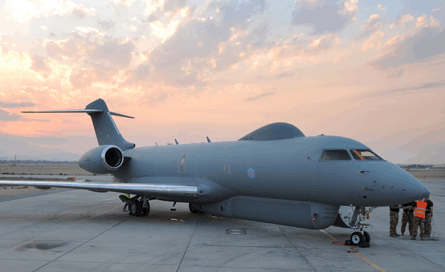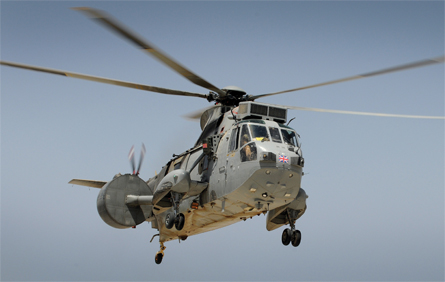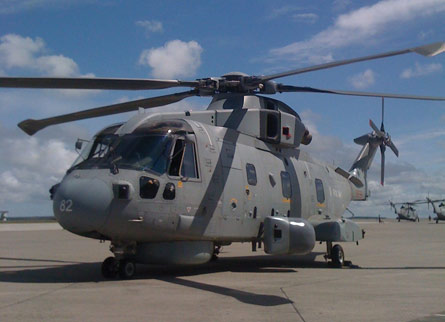Operations in Afghanistan and Libya have showcased the key service being provided by manned surveillance aircraft equipped with synthetic aperture radar (SAR) and ground moving target indication (GMTI) sensor payloads, but also highlighted the sparse availability of such assets among coalition forces.
For the UK in particular, 2011 has validated its past investments in the Royal Air Force's Raytheon Systems Sentinel R1 aircraft and the Royal Navy's Westland Sea King 7 airborne surveillance and control (ASaC) helicopters. But it has also raised questions about the Ministry of Defence's long-term commitment to the systems, which face starkly different futures under controversial spending plans.
 |
|---|
| © Crown Copyright The UK's Sentinel R1s have flown more than 7,300h over Afghanistan and Libya, but face possible early retirement due to spending cuts |
While the navy wants to replace its Thales Searchwater 2000 radar-equipped ASaC fleet, the air force's Bombardier Global Express-based Sentinels could be removed from service dramatically early. The latter proposal was outlined in the Strategic Defence and Security Review of September 2010, which identified a plan to "withdraw the Sentinel surveillance aircraft once it is no longer required to support operations in Afghanistan". The UK hopes to scale back its current contribution of ground forces to the NATO-led campaign from 2015.
TOUR OF DUTY
Providing the information-gathering element of the airborne stand-off radar system, Sentinel R1s of the RAF's 5 Sqn are in action in both theatres of operation, flown from forward operating locations in the Middle East and Italy. The RN's Sea King 7s are now being flown in Afghanistan only, but also completed a roughly four-month tour of duty in support of the NATO mission to protect Libyan civilians from late May. This saw two aircraft log almost a combined 100 sorties from the helicopter carrier HMS Ocean.
Both aircraft types provide the ability to acquire so-called "pattern of life" data of the ground environment. Analysts in the air and on the ground can identify unusual activities, such as a reduction in vehicle movements, which could indicate the placement of improvised explosive devices. Using GMTI data, mission system operators are also able to track individual vehicles, with Sea Kings having helped the US Marine Corps to apprehend bomb makers in Afghanistan.
 |
|---|
| © Crown Copyright |
The navy must soon move to replace its ASaC fleet, as UK operations with the venerable Sea King are due to end by about 2016. Although being used in an overland surveillance role, the aircraft's main intended application is to provide an airborne early warning function for aircraft carriers. September's Defence and Security Equipment International (DSEi) show in London provided an insight into the thinking of two prime candidates to meet the requirement.
Thales UK outlined an idea to adapt the Sea King's Searchwater radar and Cerberus mission system for installation on some of the RN's AgustaWestland AW101 Merlins. The sensor would be deployed using elevator rails attached to the side of the fuselage.
"Our sensor is fully multi-role over water, air-to-air and overland. We are the only system of the kind already in operational use for the role required," says Nick Marks, head of ASaC development for Thales. "The MoD has bought the equipment, and it's doing a great job in Afghanistan."
Thirty of the navy's Merlins will be upgraded to the multimission HM2 standard under a programme led by prime contractor Lockheed Martin UK. All could be capable of carrying the next-generation airborne surveillance mission equipment, with about one-third to potentially have it installed at any one time. Lockheed revealed at DSEi that it has already conducted a trial installation of a proposed new airborne sensor concept for the Merlin. Contained in pylon-mounted pods on either side of the fuselage, gimballed active electronically scanned array radars combine to provide 360° coverage for tasks such as fighter control and maritime and battlefield surveillance.
Each fully equipped pod would weigh about 280kg (617lb), and one industry source suggests the radar technology could be derived from Northrop Grumman's work on Lockheed's F-35 Joint Strike Fighter. With the MoD yet to launch an assessment phase study on its ASaC replacement options, AgustaWestland has secured an urgent operational requirement (UOR) contract to provide a secure communications upgrade for part of the current fleet. Eleven are in active use, as assessed by Flightglobal's HeliCAS database. It will design, develop, manufacture and install the equipment, with modifications to occur between November 2011 and June 2013.
OPERATIONAL REQUIREMENTS
Based at Waddington, Lincolnshire and delivered between 2002 and 2004, the RAF's Sentinel fleet comprises five heavily modified Bombardier Global Express business jets. These have logged more than a combined 10,000 flight hours, including 5,300 accumulated in Afghanistan since 2009 and 2,000-plus flown over Libya since March 2011. The service confirms the aircraft have been subject to UOR activity "to meet specific operational requirements in support of operations in Afghanistan", but says further details are classified.
 |
|---|
| © Lockheed Martin Lockheed wants to modify the AW101 Merlin |
"Despite limited numbers, the Sentinel fleet has provided critical support to both Afghan and Libyan theatres and on one occasion the entire fleet was airborne," Air Vice Marshal Stuart Atha, air officer commanding the RAF's 1 Group organisation, told London's Chatham House institute in a recent speech. Also assigned to 5 Sqn are four Hawker Beechcraft King Air 350CERs acquired under a UOR deal and referred to as Shadow R1s. Modified by Raytheon, these carry L-3 Wescam MX-15 electro-optical/infrared cameras and other intelligence-gathering sensors. The MoD currently has no formal plan to use these aircraft post-Afghanistan.
If also retired, the loss of the Sentinel would deplete the UK's surveillance capabilities. While the RAF's armed General Atomics Aeronautical Systems Reapers and the British Army's incoming Thales/Elbit Systems Watchkeeper unmanned air vehicles have SAR/GMTI sensors, these are suitable only for use from short ranges. Potentially a joint development and acquisition with France, the MoD's planned Scavenger unmanned system could offer a wider area performance, but would not match that of the large radar mounted beneath the Global Express. Balancing such a pressing capability need against the available budget will be a tough task.
Elsewhere, the first of three "Airseeker" signals intelligence aircraft for the RAF has been in work at L-3 Communications' Greenville site in Texas since January. The ex-Boeing KC-135 tanker is being modified as an equivalent to the US Air Force's RC-135 Rivet Joint, and is now having new wiring installed.
"The aircraft will emerge from the conversion ready for flight testing in the summer of 2013 with the Block 10 mission system," says the UK's Defence Equipment & Support organisation. RAF personnel are now flying on USAF RC-135s under a bilateral co-operation agreement which will last at least 25 years.
To enter use after 2014, the Airseekers will replace the UK's British Aerospace-built Nimrod R1s, the last of which left service in late June after a final flourish in Afghanistan and Libya. Atha says that despite its age, the Nimrod R1 was "still able to intercept and pinpoint communications with unmatched accuracy" prior to its retirement.
Source: Flight International
















